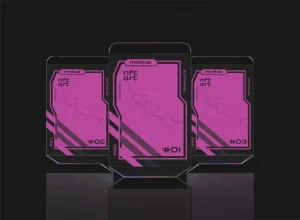
By Jeff Peterson, editor-in-chief, PostPress
The trading card industry continues on a positive trajectory. Just the sporting trading card industry alone expects to reach over $2881.7 million by 2028. The industry was strong before the pandemic, but COVID-19 sparked a resurgence that has continued today and is expected to continue well into the future. Other trends that have sparked growth include NFT (non-fungible tokens) integration that offers a novel digital experience, increases in special editions and autographs, and the overall online marketplace that has facilitated the ease of buying and selling trading cards.
At the core of the design of today’s trading cards is the use of specialty embellishments to help create differentiation and value. The creativity and application of metallics, specialty UV coatings, laminates and other embellishments continue to grow and prosper.
At the recent 2024 Print Embellishment Conference (sponsored by FSEA), one of the panels included a group of experts involved in the production of sporting and gaming trading cards. With the conference taking place in Dallas, Texas, the epicenter for trading card production in the US, the event provided a perfect landscape to bring sources together from different sections of the production process. The panel included Brandon Lesley, Fanatics; Jim Singer, Brodnax 21C Packaging; Stefan Congram, Cartamundi; and Doug Fontana, Xplor Group.
Trading cards (both sports and gaming cards) have seen a new spike in popularity in the last few years. Can you discuss why you believe this has happened, and do you foresee this growth continuing in the future?
 Lesley: During the pandemic, people found new ways to spend their time and money, and people really got back into collecting. And, I predict the market will continue to increase and remain steady over the next 10 to 20 years for sure.
Lesley: During the pandemic, people found new ways to spend their time and money, and people really got back into collecting. And, I predict the market will continue to increase and remain steady over the next 10 to 20 years for sure.
Singer: We have been printing and embellishing trading cards for many years. We have moved to cold foiling even base cards that are not the main collectibles. We also have been building up our digital workload and recently added 40″ digital printing and digital embellishment processes to our operation.
Fontana: I believe the pandemic certainly had a huge impact, with people staying at home and looking for hobbies. That clearly was the reason for the spike. We do a great deal of the finishing work on the trading cards, and the innovative ideas are amazing and are keeping the collectors interested.
Congram: We work on the gaming side of trading cards, and the pandemic certainly had a major impact. A lot of people who played board games in the 1990s as kids were bringing the board games back out again. And, coming out of the pandemic, there have been new licenses and new entrants in the gaming market that are sparking even more growth.
Both metallic and coating embellishment technologies continue to dominate the design and production of trading cards. Why do you believe this is the case? What drives the use of specialty effects and embellishments for cards?
Congram: It is the nature of the product itself for both gaming and sports cards. Collectors receive the cards in a sealed pack, and it is all about the chase. It is a treasure hunt. So, the nicer the piece of treasure is, the more valuable that chase card is that you’re looking for. The embellishments elevate the aesthetics of the card of that player and directly drive up the value of the card.
Fontana: Embellishments dominate the card world. It is the appeal and the hunt for the perfect card – a card that someone else doesn’t have. The trading card companies keep asking us to push the limits with specialty effects.
Singer: With new digital embellishment technology, set-up time is very quick and the tooling is zero, so we can provide all types of samples and prototypes and do a lot of innovative things with the cards. This provides the trading card companies additional choices for foils and specialty coatings.
Lesley: Collectors want to feel and touch things. We live in a digital world where everything is disposable. When people buy cards, they keep them. We discuss this with our designers all the time. You are designing something that someone can pass down to their grandchildren, as opposed to marketing materials or a digital asset. Embellishments make a difference because they create emotion for the collector as they go through packs – they are looking for something that really jumps out, as well as the texture and the shininess of it. People want something that makes them feel different as they break open a card pack.
What types of embellishments are you seeing being used on trading cards? Are you seeing growth in any specific type of embellishment technique or process?
Singer: We have invested a great deal in digital embellishment technology for trading cards, opening up new opportunities. We can create an etching effect using the raised polymer over the top of the foil with stunning effects. We also can get very fine line work with foil and spot coatings with our digital embellishment technology. We continue to try to innovate. Recently, we laid down a cold foil on a second surface so you can see through the adhesive to the foil. When you look at it from the front side, it looks like a piece of glass. The sky is the limit because our customers always are asking – what if we do this?
Fontana: We have been seeing a great deal of clear plastic, synthetic paper and other variable stocks. There continues to be R&D on different substrates and embellishments.
Congram: Certainly, different types of paper and substrates are being used. Some of our new games want a specific holographic pattern developed for them that has never been seen before. Three-dimensional holograms are making a comeback, too. I have seen new requests for registered holograms or patterns. The holograms also are important for authentication or anti-counterfeiting.
How has the increase in digital embellishment processes enhanced the growth of digital for larger runs that are done more conventionally with hot or cold foil processes?
Fontana: Digital embellishment technologies have allowed printers and finishers to be extremely creative for those special valuable cards in a pack. The lower-value cards go through embellishment processes as well – usually more traditional foil stamping, UV coating or cold foil. I believe that is where it is. The digital embellishment processes are being used for high-end, difficult-to-find cards in each pack.
Singer: Even more standard cards include cold foil and other processes, so the expectations are higher for every type of card. We, hypothetically, can run a mass volume with our traditional platform and through our digital processes, adding additional embellishments on certain cards. All the processes are working together – conventional processes with digital – creating even cooler, more interesting cards.
What types of changes do you predict for the trading card industry in the future? Do you believe embellishment processes will continue to be an important part of the industry moving forward?
Lesley: In the next three to five years, embellishments will continue to be a very important part of the trading card market – probably the most important part. You have to create value in different ways, and I think you do that through embellishments. Innovations and new processes will continue to happen. We have done more testing in the last year than we have in the previous six years on new processes and ideas and how to use them on cards.
Congram: I believe the complexity of processes will be a given. It’s not going to get simpler. We continue to have requests to make the creativity for our games and cards more exclusive. I predict more short runs and more frequent releases (drops) in the market. However, costs still will be a factor. We will have to find ways to keep costs in line. As the rarity model sort of shifts, and we want to give more people more rare cards, we are going to see the evaluation of production costs more heavily scrutinized.

